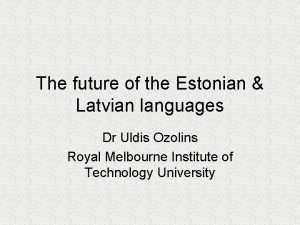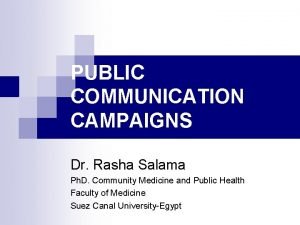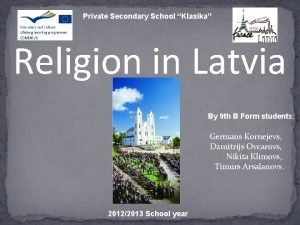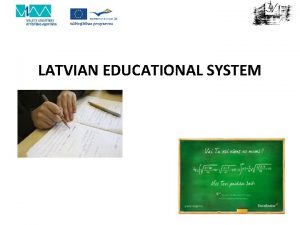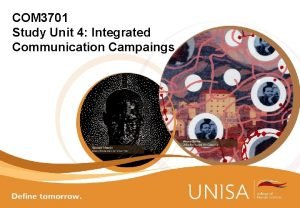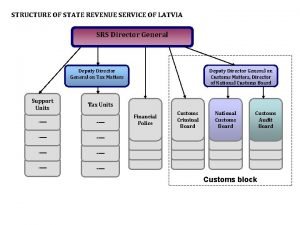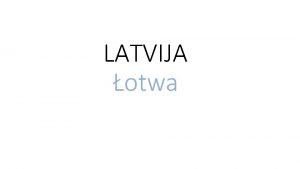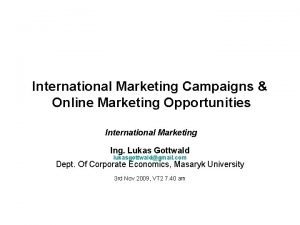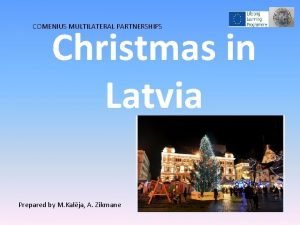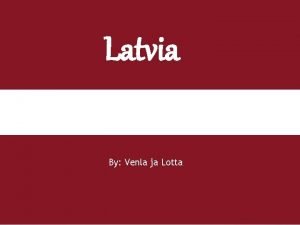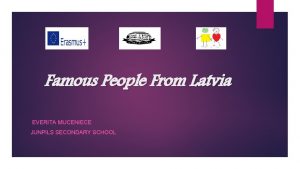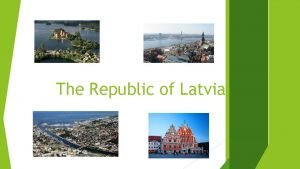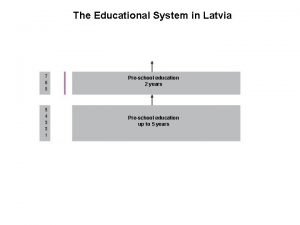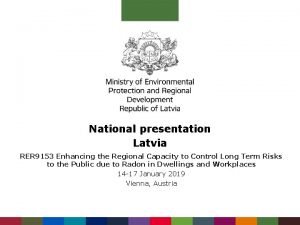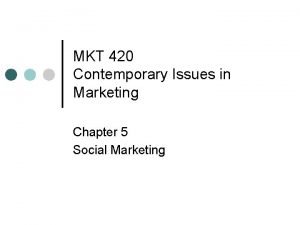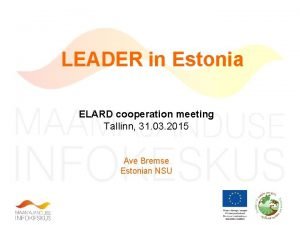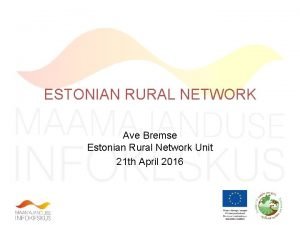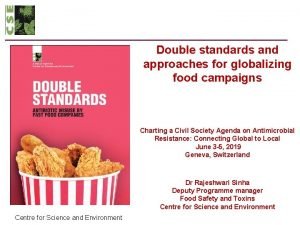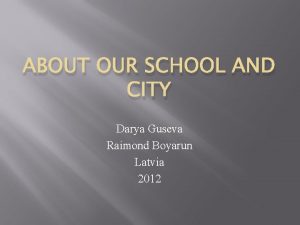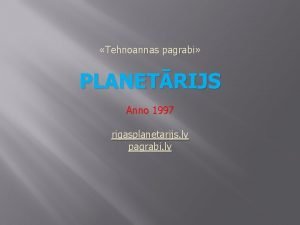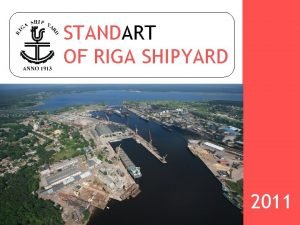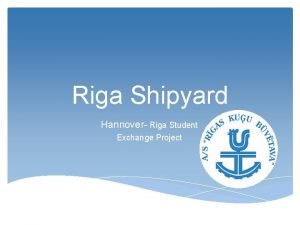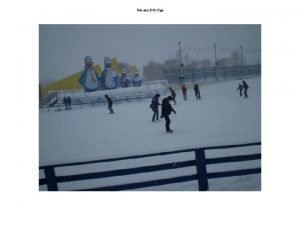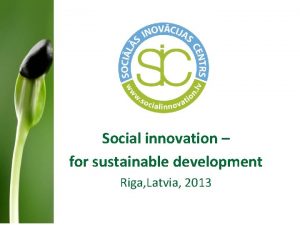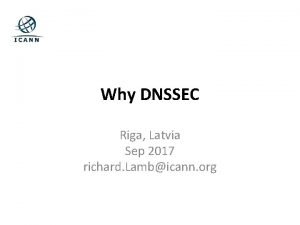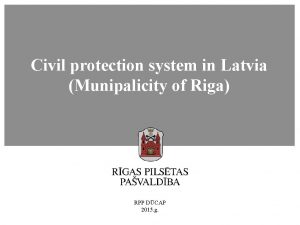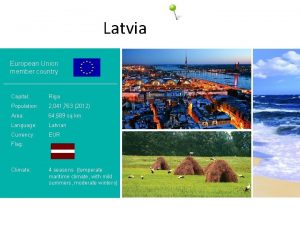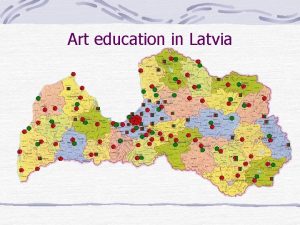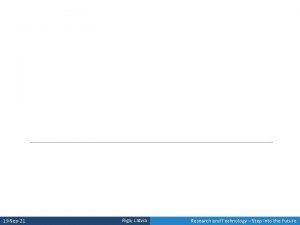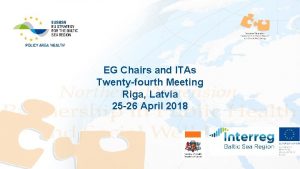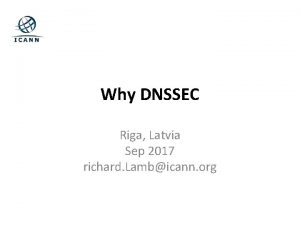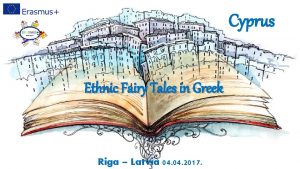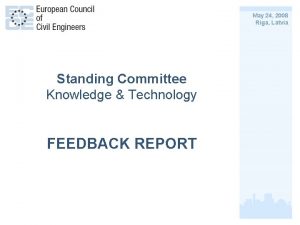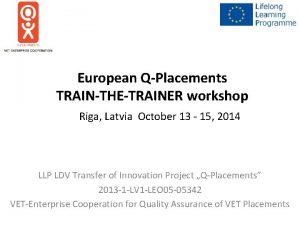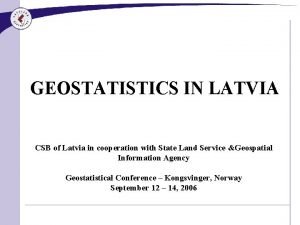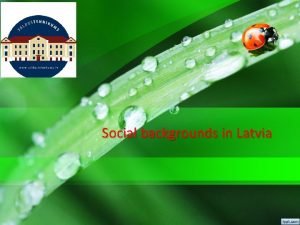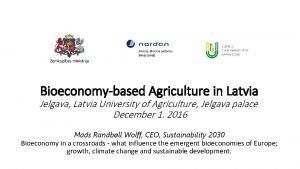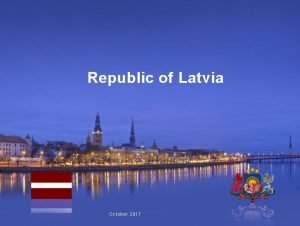Case study from Riga Latvia campaigns within the


























- Slides: 26

Case study from Riga (Latvia) – campaigns within the project «Different people. Different experience. One Latvia» Alda Sebre Society Integration Foundation Ilona Stalidzāne Municipality of Riga Dresden, September 21 -23

Population (01. 2016) Population of Latvia Ethnic group Number Latvians 1 284 767 Russians Belarusians Ukrainians Poles Lithuanians Jews Other ethnic groups Total in Latvia 566 681 70 803 51 576 46453 27 000 8 679 88 804 2 144 763 Percent 59. 9 26. 4 3. 3 2. 4 2. 2 1. 3 0. 4 4. 1 Population of Riga Latvians Russians Belarusians Ukrainians Poles Other ethnic groups Total in Riga Number Percent 302688 269849 26571 25864 13020 26975 45. 5 40. 6 4. 0 3. 9 2. 0 4. 1 664967

Increase of foreign nationals in Latvia 01. 2012 01. 2016 60 285 foreign residents in Latvia 88 576 foreign residents in Latvia � 44 328 with permanent residence permits 4 271 - EU/EEZ citizens, 40 057 - third country nationals Representatives of 56 countries � 52 001 with permanent residence permits 4 398 - EU/EEZ citizens, 47 603 - third country nationals Representatives of 98 countries � 15 957 with temporary residence permits. 6 591 - EU/EEZ citizens, 9 366 - third country nationals Representatives of 79 countries � 36 575 with temporary residence permits. 10 814 - EU/EEZ citizens, 25 761 - third country nationals Representatives of 120 countries

Asylum seekers � 1998 - the asylum procedure started � 1946 persons applied for asylum in Latvia (data on August 2016) � in total, 106 person received refugee and 183 persons received alternative status (subsidiary protection) by August 2016. � asylum seekers in the last years mainly come from Georgia, Ukraine, Syria, Afghanistan and Iraq. � 531 asylum seekers to be accepted within the next two years under EU resettlement scheme (Latvia was ready for 776). 69 persons arrived (data on August 2016)

Newcomer integrationchallenges �Lack of knowledge of Latvian language �Limited access to social protection (including health, education and employment etc. ) �Reserved attitude towards newcomers (visually different, religion, etc. ) �Limited awareness raising activities and examples of good practices


TASK �WHAT VIDEO? �HOW IS THE MAIN MESSAGE OF THIS COULD YOU TITLE THIS VIDEO ?

http: //ej. uz/tar 9

Projects "Different people, various experiences, one Latvia" I and II The aim of the projects was identification of innovative approaches and dissemination of good practice to promote anti-discrimination and equality principles in Latvia.

Projects "Different people, various experiences, one Latvia" I and II Core activities • Capacity strengthening of core actors on non-discrimination, equality issues and diversity management. Trainings were organised for more than 300 specialists from different sectors (journalists, PR and communication specialists, high level officials, judges, lawyers, NGO and public sector representatives etc. ) • Awareness raising campaigns • Surveys on diversity management in companies, Roma situation in Latvia • Supporting activities to raise awareness of Roma and support their integration

Projects "Different people, various experiences, one Latvia" I and II Target group(s) � Public institutions � Civil society organizations (NGOs) � High level public officials � Journalists, PR and communication specialists � School teachers � Judges, lawyers, prosecutors and advocates � Schoolchildren and young people � People experiencing discrimination � Society in general

Projects "Different people, various experiences, one Latvia" I and II Partners �Public institutions – ministries �Civil society organizations (NGOs) Time frame 2 years Financial resources ~500 000 EUR

The activity “Awareness raising of general public I” was foreseen with an objective to increase public awareness of discrimination issues and to promote equality. The following activities were organised in order to address society to explain equality issues and disseminate knowledge on nondiscriminative attitude: outdoor advertisement campaign; publications on national, regional and internet media; TV broadcasts; thematic days; creative and interactive events in schools; Ambassadors of Good Will and Diversity award. As the result of the activities the issue of equality and nondiscrimination issues has been raised and awareness of general public about 6 discrimination grounds has increased.

The following activities and events were conducted within the communication campaign: • outdoor advertisements (posters) campaign on 6 grounds of discrimination (6 different posters; 1000 copies; in 7 cities conducted, 87 100 persons reached); • regular thematic articles for national, regional newspapers, as well as for internet media on discrimination and equality issues (157 publication initiated); • competition of publication and TV broadcasts “Diversity equalise” (11 competitors – journalists and publishers for 3 different categories); • TV broadcast about discrimination and equality issues in national television (48 000 persons reached)

• 4 thematic days: 8 April - International Roma day and Roma holocaust memory day; 10 May - World Day for Cultural Diversity for Dialogue and Development (the organisation of the event included flash mob); 1 June - International Day for Protection of Children; 1 July - Equality and diversity movie night (all together 1140 people attended thematic days, 80 publications initiated); • 5 interactive and creative activities for children and young people on tolerance and non-discrimination (150 children involved); • competition of children creative works on tolerance and non-discrimination (135 competitors in 3 different categories)




Activity – Roma Day

Activity – diversity mainstreaming

The activity “Awareness rising of general public II” Awareness-raising activities targeted at the general public by demonstration of cases of discrimination through digital storytelling. 7 video stories were produced on 6 grounds of discrimination by giving a voice to the representatives of discriminated groups. Video stories were broadcasted in social media, internet media, televisions, cinemas and had initiated intensive public discussions.

Results • Video stories broadcasting in social media has attracted more than 350 000 viewers in Latvia and abroad and in several TV channels (4 TV channels were used) has ensured audience 20 000 – 30 000 in each. • The promotional video (trailer) has been created in order to raise the interest to watch all the video stories. It was shown in 3 cinemas reaching the audience of more than 6000 people (parents with pre-school and younger school-age children (age of 12 -34), as well as in different social media. • The social media network focusing on young people has been used, for example, www. draugiem. lv (similar to Facebook, only Latvian version) reaching 224 viewers and 55 followers. • Within the project the video stories were recorded on DVD in order to approach the young people in more tangible way, for example ensuring the video watching with open discussions during social sciences lessons in schools.

Main challenges • • Elaboration of the script Consultations with target group New regulations/Political discussions ( «correct» norms of virtues of society) Attraction of the attention of the society

SEVEN STORIES ABOUT US http: //ej. uz/8 ac 9

Questions • Have you ever had a negative experience in implementing public campaign (for example, message was not properly formulated, resistance from grass roots or state/NGOs)? What was your reaction (Has the campaign been stopped? What was the crisis communication? )? • Have you taken into account negative opinion makers while creating the campaign or other activities by confronting their opinions by the messages of the campaign? • What kind of methods and information channels do you use while working with grassroots in order to promote tolerance in the society?

Thank you!
 Best worst and average case
Best worst and average case It project failure case study
It project failure case study Is latvia slavic
Is latvia slavic Meaning of public communication
Meaning of public communication Religion in latvia
Religion in latvia Latvia school system
Latvia school system Com3701
Com3701 Srs latvia
Srs latvia Riga to stolica
Riga to stolica International marketing campaigns
International marketing campaigns Latvia christmas traditions
Latvia christmas traditions Latvian kansallislintu
Latvian kansallislintu Informed delivery campaigns
Informed delivery campaigns Latvia famous person
Latvia famous person Republic of latvia
Republic of latvia What is post graduation
What is post graduation Latvia population
Latvia population Latvia
Latvia Post campaign analysis presentation
Post campaign analysis presentation What is strategic brand communication
What is strategic brand communication Contemporary issues in marketing
Contemporary issues in marketing Gastronauts latvia
Gastronauts latvia Gastronauts latvia
Gastronauts latvia Fast food campaigns
Fast food campaigns Jackie chan in latvia
Jackie chan in latvia Planetārijs rīgā
Planetārijs rīgā Riga shipyard
Riga shipyard


